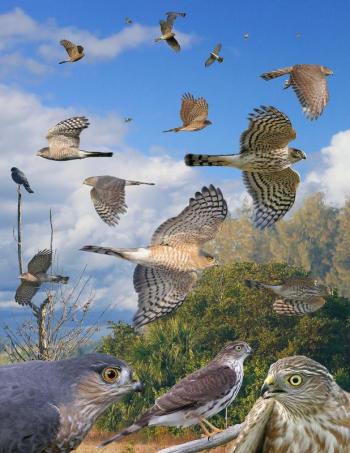A Hawk Prepares Dinner in the Neighborhood
On a recent early evening the family was out in the yard enjoying the spring sunshine and singing birds while shooting hoops on the driveway basketball court. To be entirely accurate, we were playing a game we call “shoot till you miss” which involves taking turns shooting as many baskets as possible until one is missed, at which point the next person takes over. The first person to get twenty-one points is the winner. Son was beating both Mom and Dad but Dad on this particular day was showing a remarkable lack of luck in making the orange ball go through the hoop.
Right at the moment when the game was about to be lost, a frantic screeching sound erupted from our neighbor’s backyard. We stopped our game immediately, of course, as we attempted to learn what was making the sound. At first, we were concerned that one of the roaming cats (we keep our own indoors at all times) might have captured one of the beloved robins that have just begun setting up their territories in the nearby yards, the males caroling loudly every morning and evening.
But no cats in sight.
Walking a bit closer we noticed flapping movements coming from an open area of lawn underneath the tall maples that separate two nearby homes. Clearly a hawk of some kind had another bird in its grasp, but the scene was still a little too distant to make out exactly the two players in this life and death drama.
We darted back inside for the binoculars while the screeching and flapping continued, and finally got a clear view from enough distance that we knew we were not disturbing the scene. The hawk was a rather small sharp-shinned hawk, still in its brown and streaky immature plumage, and on the ground in the grasp of his yellow feet was a shiny black European starling.
Sharp-shinned hawks are the smallest of the three North American species of hawks in the Accipiter family, a group of hawks that specialize almost completely in catching and eating other birds. The largest of the three in the family is the well-known goshawk, which favors more heavily wooded environments and is particularly suited to prey on ruffed grouse. The middle-sized Accipter is the Cooper’s hawk, the females of which can be about the size of a crow (males in most hawks, including these, are smaller than the females). The sharp-shinned hawk, in contrast, is just a bit bigger than a blue jay, especially the smaller males.
The sharp-shinned hawk we were watching in our neighbor’s yard was not particularly large, probably a male, and we had to wonder also about how skilled it was at incapacitating its prey. While it did have the starling in its grasp on the ground, the screeching and flapping struggles went on and on. As we watched, the hawk apparently gave up on the idea of killing the starling with its sharp claws and began plucking feathers from it instead.
What was also amazing was that this scene was going on only about thirty feet from another neighbor’s young dog who was, like us, watching intently and only staying away because of the invisible fence that it had been trained to stay within only a week or two before. A few feet from the dog was the neighbor himself, working on his car with the hood up. Despite all this activity and cars passing on the street about fifty feet away, the hawk never stopped. We could only imagine how much this starling meal must have meant for its own survival.
Eventually, after much plucking, the starling stopped struggling and quieted. The hawk, perhaps feeling the intruding gaze of human and dog, opened its wings and hunched over its food as if to say “mind your own business” and continued picking pieces of flesh from the body and swallowing them hungrily.
We drifted back toward the basketball court but the memory of the game had faded and our own stomachs suggested that perhaps it was time for us to pursue our own hunting trip—to the grocery store.
Jeffrey V. Wells, Ph.D., is a Fellow of the Cornell Lab of Ornithology and Vice President of Boreal Conservation for National Audubon. Dr. Wells is one of the nation's leading bird experts and conservation biologists and author of the “Birder’s Conservation Handbook.” His grandfather, the late John Chase, was a columnist for the Boothbay Register for many years. Allison Childs Wells, formerly of the Cornell Lab of Ornithology, is a senior director at the Natural Resources Council of Maine, a nonprofit membership organization working statewide to protect the nature of Maine. Both are widely published natural history writers and are the authors of the popular books, “Maine’s Favorite Birds” (Tilbury House) and “Birds of Aruba, Bonaire, and Curaçao: A Site and Field Guide,” (Cornell University Press).































